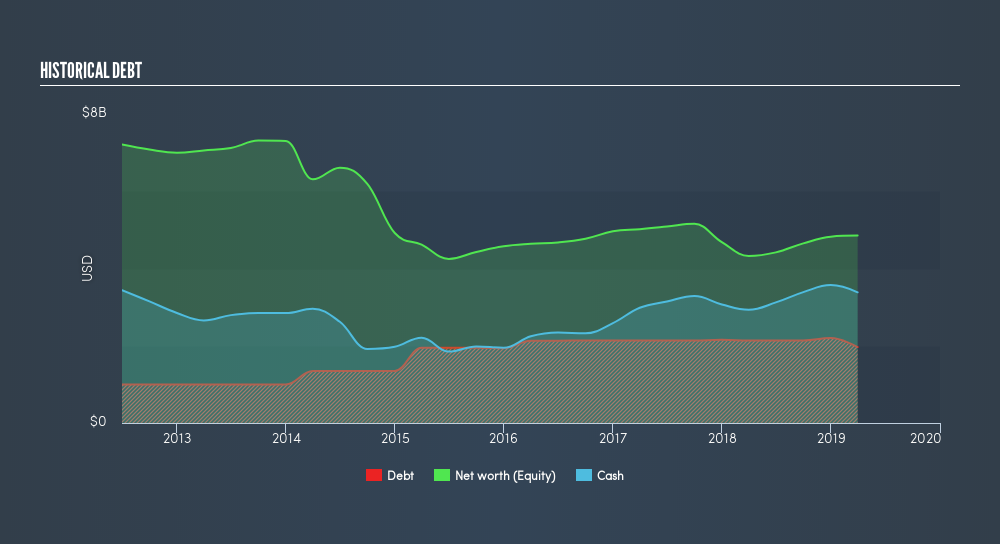- United States
- /
- Communications
- /
- NYSE:JNPR
What You Must Know About Juniper Networks, Inc.'s (NYSE:JNPR) Financial Strength

Want to participate in a short research study? Help shape the future of investing tools and you could win a $250 gift card!
The size of Juniper Networks, Inc. (NYSE:JNPR), a US$9.7b large-cap, often attracts investors seeking a reliable investment in the stock market. Risk-averse investors who are attracted to diversified streams of revenue and strong capital returns tend to seek out these large companies. However, the key to extending previous success is in the health of the company’s financials. Let’s take a look at Juniper Networks’s leverage and assess its financial strength to get an idea of their ability to fund strategic acquisitions and grow through cyclical pressures. Note that this commentary is very high-level and solely focused on financial health, so I suggest you dig deeper yourself into JNPR here.
See our latest analysis for Juniper Networks
JNPR’s Debt (And Cash Flows)
Over the past year, JNPR has reduced its debt from US$2.1b to US$2.0b – this includes long-term debt. With this debt payback, the current cash and short-term investment levels stands at US$3.4b , ready to be used for running the business. Additionally, JNPR has produced cash from operations of US$749m during the same period of time, leading to an operating cash to total debt ratio of 38%, indicating that JNPR’s current level of operating cash is high enough to cover debt.
Can JNPR meet its short-term obligations with the cash in hand?
With current liabilities at US$1.5b, the company has maintained a safe level of current assets to meet its obligations, with the current ratio last standing at 2.89x. The current ratio is calculated by dividing current assets by current liabilities. For Communications companies, this ratio is within a sensible range as there's enough of a cash buffer without holding too much capital in low return investments.

Is JNPR’s debt level acceptable?
With debt reaching 41% of equity, JNPR may be thought of as relatively highly levered. This is not unusual for large-caps since debt tends to be less expensive than equity because interest payments are tax deductible. Since large-caps are seen as safer than their smaller constituents, they tend to enjoy lower cost of capital. No matter how high the company’s debt, if it can easily cover the interest payments, it’s considered to be efficient with its use of excess leverage. A company generating earnings after interest and tax at least three times its net interest payments is considered financially sound. For JNPR, the ratio of 19.31x suggests that interest is comfortably covered. Large-cap investments like JNPR are often believed to be a safe investment due to their ability to pump out ample earnings multiple times its interest payments.
Next Steps:
JNPR’s high cash coverage means that, although its debt levels are high, the company is able to utilise its borrowings efficiently in order to generate cash flow. Since there is also no concerns around JNPR's liquidity needs, this may be its optimal capital structure for the time being. Keep in mind I haven't considered other factors such as how JNPR has been performing in the past. I recommend you continue to research Juniper Networks to get a more holistic view of the large-cap by looking at:
- Future Outlook: What are well-informed industry analysts predicting for JNPR’s future growth? Take a look at our free research report of analyst consensus for JNPR’s outlook.
- Valuation: What is JNPR worth today? Is the stock undervalued, even when its growth outlook is factored into its intrinsic value? The intrinsic value infographic in our free research report helps visualize whether JNPR is currently mispriced by the market.
- Other High-Performing Stocks: Are there other stocks that provide better prospects with proven track records? Explore our free list of these great stocks here.
We aim to bring you long-term focused research analysis driven by fundamental data. Note that our analysis may not factor in the latest price-sensitive company announcements or qualitative material.
If you spot an error that warrants correction, please contact the editor at editorial-team@simplywallst.com. This article by Simply Wall St is general in nature. It does not constitute a recommendation to buy or sell any stock, and does not take account of your objectives, or your financial situation. Simply Wall St has no position in the stocks mentioned. Thank you for reading.
About NYSE:JNPR
Juniper Networks
Designs, develops, and sells network products and services worldwide.
Flawless balance sheet with solid track record and pays a dividend.
Similar Companies
Market Insights
Community Narratives


